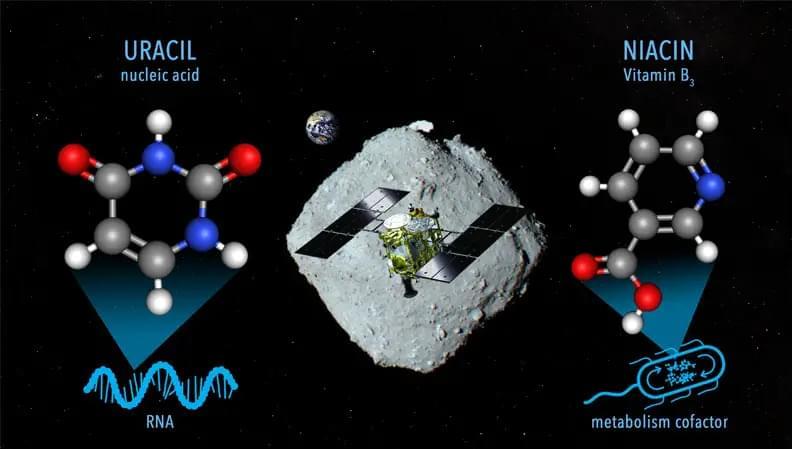Interesting results from the Japanese Hayabusa2 spacecraft — molecules needed for life were found in samples from the asteroid Ryugu.
The mission will now continue until at least 2031.

Interesting results from the Japanese Hayabusa2 spacecraft — molecules needed for life were found in samples from the asteroid Ryugu.
The mission will now continue until at least 2031.

Stanford’s Alpaca AI performs similarly to the astonishing ChatGPT on many tasks – but it’s built on an open-source language model and cost less than US$600 to train up. It seems these godlike AIs are already frighteningly cheap and easy to replicate.
Just a couple of years earlier, in 1963, New Zealand mathematician Roy Kerr found a solution to Einstein’s equation for a rotating black hole. This was a “game changer for black holes,” Giorgi noted in a public lecture given at the virtual 2022 International Congress of Mathematicians. Rotating black holes were much more realistic astrophysical objects than the non-spinning black holes that Karl Schwarzschild had solved the equations for.
“Physicists really had believed for decades that the black hole region was an artifact of symmetry that was appearing in the mathematical construction of this object but not in the real world,” Giorgi said in the talk. Kerr’s solution helped establish the existence of black holes.
In a nearly 1,000-page paper, Giorgi and colleagues used a type of “proof by contradiction” to show that Kerr black holes that rotate slowly (meaning they have a small angular momentum relative to their mass) are mathematically stable. The technique entails assuming the opposite of the statement to be proved, then discovering an inconsistency. That shows that the assumption is false. The work is currently undergoing peer review. “It’s a long paper, so it’s going to take some time,” Giorgi says.
What exactly is light—and what is it made of? It’s an age-old question that dates back to antiquity, and one of the most important investigations undertaken by scientists looking to understand the nature of reality.
Researchers at Texas A&M University have developed the first molecular therapeutic for Angelman syndrome to advance into clinical development.
In a new article, published today in Science Translational Medicine, Dr. Scott Dindot, an associate professor and EDGES Fellow in the Texas A&M School of Veterinary Medicine and Biomedical Sciences’ (VMBS) Department of Veterinary Pathobiology, and his team share the process through which they developed this novel therapeutic candidate, also known as 4.4.PS.L, or GTX-102. Dindot is also the executive director of molecular genetics at Ultragenyx, which is leading the development of GTX-102.
Angelman syndrome (AS) is a devastating, rare neurogenetic disorder that affects approximately 1 in 15,000 live births per year; the disorder is triggered by a loss of function of the maternal UBE3A gene in the brain, causing developmental delay, absent speech, movement or balance disorder, and seizures.
(CNN) — Startup Relativity Space sent what it’s calling the “world’s first 3D-printed rocket” toward space on Wednesday, vaulting it into the upper reaches of the atmosphere. Though, it suffered an engine issue after launch and failed to reach orbit.
Terran 1, a 110-foot-tall (33.5-meter) vehicle designed to haul lightweight satellites into orbital space, lifted off from Cape Canaveral Space Force Station on Florida’s eastern coast at just before 11:30 pm ET. The rocket, powered by super-chilled methane and oxygen, burned a bright blue-green against the night sky.
After the first stage of the rocket — the bottommost portion of the rocket that gives the initial thrust at liftoff — expended its fuel, it detached from the rocket’s upper stage. But the engine meant to propel that portion appeared to ignite only briefly, leaving the rocket without enough power to reach orbit.
More than 150 million women worldwide use oral contraceptives to avoid unwanted pregnancies. However, a bombshell study released by researchers at the University of Oxford has now laid bare the risks involved. The study has reportedly established the link between the usage of progestogen and the increased risk of breast cancer.
Scientists from German Cancer Research Center (DKFZ), together with colleagues from Germany, Israel, and the U.S., have found that the gut microbiome may modulate the efficacy of CAR-T cellular immunotherapy CAR-T cells in patients with B cell lymphomas. Individualized microbiome information retrieved from patients’ gut microbiomes prior to initiation of CAR T therapy could accurately predict their subsequent responsiveness to therapy, but only in the condition that these patients were not pre-treated with broad spectrum antibiotics.
Increasing evidence from human studies and preclinical experiments suggests that the gut microbiome may modulate the efficacy of T cell-driven cancer immunotherapies, such as immune checkpoint blockade. Immunotherapy with CD19 chimeric antigen receptor (CAR)-T cell has opened up new treatment options for patients with certain forms of refractory and relapsing B-cell leukemias or lymphomas. But the therapy is hampered by considerable heterogeneity in responses. Complete and long-term remission is only achieved in up to 40% of patients.
Researchers from multiple centers in Germany and the United States, led by Eran Elinav, director of the DKFZ-Weizmann Institute of Science Microbiome & Cancer Bridging division, have found that the gut microbiome may modulate the efficacy of CD19 CAR-T cell immunotherapy in patients with B cell leukemias and lymphomas.
In this exclusive excerpt from ‘Your Brain on Art,’ we learn how sounds and images are proving to measurably heal the brain.
